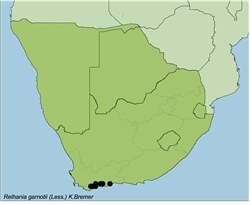Names and synonyms
Relhania garnotii (Less.) Bremer
=Polychaetia garnotii Lessing
=Nestlera garnotii (Less.) Harvey
=Nestlera tenuifolia DC.
=Nestlera garnotii (Less.) Harv. var. �. denudata Harvey
Type
Bremer 231, Bredasdorp, near road port Beaufort-Swellendam, 19 km from Port Beaufort, Kadieswagendrift (K, S, M, NU, NBG)
Derivation of names
Relhania = after Irish-born Richard Relhan (1754-1823), botanist, plant collector, bryologist, lichenologist, one of the founders of the Linnean Society, rector in Lincolnshire and author of Flora Cantabile.
garnottii = after Prosper Garnot (fl. 1822-1825) naturalist on the La Coquille. Collected in the Cape in 1825 during their voyage around the world.
Diagnostic characters
Leaves very short, ericoid
Capitula in terminal cymes
Description
A moderately branched shrublet, 0.3- 0.5 m tall. Stems ascending-erect, tomentose, leafy, becoming glabrous and nude and marked with leaf-scars. Leaves alternate, squarrose to somewhat recurved, with projecting midrib on both sides, 2-5 x 0.4-0.8 mm, usually very uniform in size, tomentose on both sides mainly in the furrows between midrib and margins, obtuse. Capitula 3-14 together in terminal cymes. Peduncles absent or on lowermost capitula up to 5 mm long. Involucre cup-shaped, 2-3.5 mm wide. Involucral bracts 25-30, outer ovate, inner gradually longer and oblong-obovate, innermost obovate-narrowly spatulate with a spreading, apical limb, dorsally gland-dotted, obtuse-rounded. Receptacle deeply alveolate. Ray florets 7-11, tube 1.4-2 mm long, glandular, lamina elliptic, 1.6-2.3 x 0.6-0.9 mm wide, 4-veined. Disc florets 11-17, sterile. Pappus crownlike of � connate scales, up to 0.5 mm long. Cypselas oblong, 1.1-1.7(-2.1) x 0.2-0.4(-0.5) mm, glabrous or pilose in ray florets.
Flowering time
Mainly from June to August.
Distribution
From Bredasdorp to George.
Known from about 16 specimens.
Habitat
Sandy and clayey flats in coastal renosterveld.
Notes
This is a rather isolated species in the genus. The small leaves are somewhat tetraquetrous with indumentum mainly in furrows between the midrib and margins. The receptacle is epaleate, but deeply alveolate with the cypselas (immature) totally embedded. These are unique conditions in Relhania.
References
BREMER, K. 1976. The genus Relhania (Compositae). Opera Botanica 40.
GLEN, H.F. & GERMISHUIZEN, G. 2010. Botanical Exploration of southern Africa. Ed. 2. Strelitzia 26. SANBI.
KESTING, D. & CLARKE, H. 2008. Botanical names, what they mean. Wild Flowers of the Cape Peninsula, 3rd revised edition. Friends of Silvermine.
